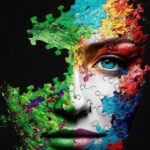In this article, we will embark on a profound journey through the realms of language, culture, and psychology to decipher the enigmatic adage, “The gaze is the reflection of the soul.
” This saying has captivated our collective imagination for centuries, evoking a sense of mystery and intrigue about the human condition and our capacity to communicate without words.
We will delve into the historical roots and cultural contexts of this adage, as well as exploring the psychological and scientific aspects that can explain its enduring appeal and significance.
Through this exhaustive exploration, we aim to illuminate the deeper truths and hidden meanings behind this powerful phrase – revealing how the gaze can indeed offer a mirror into our very souls.
Tracing the Origins: The Historical and Cultural Roots of the Saying
Our first quest in shedding light on the enigmatic saying “The gaze is the reflection of the soul” takes us back in time, as we unravel the rich tapestry of its historical and cultural origins.
Throughout human history, the eyes have been regarded as the windows to the soul, a notion that can be traced back to ancient civilizations, such as the Egyptians, Greeks, and Romans. These cultures believed that the eyes were not only the organs of sight but also the seat of spiritual, intellectual, and emotional faculties. In their art, literature, and mythology, the eyes were often depicted as symbols of wisdom, insight, and divine knowledge, reflecting the deeply-held belief in the profound connection between the gaze and the inner essence of a person.
In the Western tradition, the notion of the eyes as the mirror of the soul is deeply ingrained in the works of great philosophers, poets, and playwrights. For instance, in his famous play “Hamlet”, William Shakespeare wrote, “The eyes are the windows to the soul” – a phrase that has since become synonymous with the idea that our gaze can reveal our true emotions, thoughts, and character. Similarly, the French philosopher Jean-Jacques Rousseau once stated, “The eyes are the interpreter of the heart” – suggesting that our gaze can convey a whole range of feelings, from love and compassion to anger and jealousy.
Moreover, the adage “The gaze is the reflection of the soul” has also found resonance in Eastern philosophies, such as Buddhism and Hinduism. These spiritual traditions teach that the eyes play a crucial role in connecting us with our inner self and the divine forces of the universe. In their meditation practices, followers are often encouraged to focus on their gaze or the “third eye” – a symbolic representation of the spiritual eye, located in the center of the forehead, which is believed to grant insight, intuition, and enlightenment.
Decoding the Gaze: The Psychological and Scientific Dimensions of the Saying
Having explored the historical and cultural roots of the adage “The gaze is the reflection of the soul,” we now turn our attention to the psychological and scientific aspects that can help us to better understand the meaning and significance of this saying.
- The Gaze as a Form of Nonverbal Communication: One of the key aspects to consider when examining the connection between the gaze and the soul is the role that the eyes play in nonverbal communication. According to research, up to 93% of human communication is nonverbal, and the eyes are one of the most expressive and powerful tools we have at our disposal to convey our emotions, thoughts, and intentions. This ability to communicate through our gaze is deeply rooted in our evolutionary history, as it has allowed us to establish social bonds, coordinate actions, and convey complex information without the need for words.
- The Gaze as an Indicator of Emotions: Another crucial aspect to consider is the role that the gaze plays in expressing and perceiving emotions. Studies in the field of psychology have shown that the eyes can provide a wealth of information about a person’s emotional state, from happiness and surprise to sadness and anger. Furthermore, research has revealed that humans have a remarkable ability to accurately interpret these emotional cues from the gaze of others, even in the absence of any other contextual information.
- The Gaze as a Marker of Attention: The relationship between the gaze and the soul can also be understood in terms of the role that the eyes play in directing our attention and focus. Research has demonstrated that our gaze can reveal a great deal about our cognitive processes, interests, and motivations. For example, studies have shown that people tend to fixate their gaze on objects or individuals that capture their attention, curiosity, or desire, while avoiding eyecontact in situations where they may feel threatened, anxious, or shy.
- The Gaze as a Window into the Mind: Lastly, the link between the gaze and the soul can be further elucidated through the concept of “Theory of Mind” – the ability to attribute mental states, such as beliefs, desires, and intentions, to oneself and others. Research in fields such as cognitive psychology and neuroscience has shown that our gaze can provide valuable insights into our mental states and thought processes. By observing the gaze patterns and eye movements of others, we can gain a deeper understanding of their perspectives, beliefs, and intentions, thereby fostering empathy, compassion, and social connection.
Artistic Expressions and Symbolism: The Gaze as a Reflection of the Soul in Art and Literature
Now that we have examined the psychological and scientific dimensions of the saying “The gaze is the reflection of the soul,” it is important to also consider its artistic and symbolic manifestations, which offer yet another layer of meaning and interpretation.
- Portraiture: In visual art, particularly in portraiture, the eyes have long been considered the focal point of a painting, capturing the essence and spirit of the subject. Artists throughout history, from Leonardo da Vinci to Vincent van Gogh, have sought to portray the truth of the human soul through the eyes of their subjects, using various techniques, such as chiaroscuro, to accentuate the gaze and imbue it with emotion and depth.
- Literature: Similarly, in literature, the eyes have been a recurring motif and symbol, representing the innermost emotions, thoughts, and desires of characters. From the piercing gaze of Heathcliff in Emily Bronte’s “Wuthering Heights” to the enigmatic eyes of Dr. T.J. Eckleburg in F. Scott Fitzgerald’s “The Great Gatsby,” the gaze serves as a powerful literary device, allowing readers to delve into the depths of a character’s soul and explore the complexities of the human condition.
- Cinematography: In the realm of film, the gaze holds a unique power in conveying emotions, thoughts, and intentions without the need for dialogue. Directors and cinematographers often utilize close-ups, lighting, and camera angles to highlight the eyes of actors, inviting the audience to connect with the characters on a deeper, more intimate level. Iconic examples include the haunting gaze of Charlie Chaplin in “City Lights” or the intense stare of Al Pacino in “The Godfather.”
- Symbolism: Beyond these artistic forms, the eyes and the gaze hold deep symbolic significance in various cultural and religious contexts. For example, in Christian iconography, the “all-seeing eye” represents the omnipresence and omniscience of God, while in Hinduism, the “eye of wisdom” symbolizes the awakening of spiritual consciousness and the attainment of enlightenment. These symbols further underscore the notion that the gaze can serve as a mirror, reflecting the spiritual dimensions of our very souls.
Practical Applications and Implications: Harnessing the Power of the Gaze in Everyday Life
Having explored the historical, psychological, scientific, and artistic dimensions of the saying “The gaze is the reflection of the soul,” we now turn our attention to the practical applications and implications of this adage in our daily lives.
First and foremost, recognizing the power of the gaze as a form of nonverbal communication can help us to become more attuned to the emotional cues and signals of others, fostering empathy, understanding, and compassion in our relationships. By paying close attention to the eyes of our loved ones, friends, and colleagues, we can gain valuable insights into their feelings, needs, and desires, allowing us to respond with care and sensitivity.
Secondly, being aware of the connection between the gaze and our own emotions can enable us to better regulate and express our feelings, leading to greater emotional intelligence and well-being. By cultivating self-awareness and mindfulness, we can learn to control our gaze and use it as a tool for conveying our emotions in a more authentic, congruent, and effective manner.
Lastly, appreciating the multi-dimensional nature of the gaze – as a reflection of our emotions, thoughts, and character – can inspire us to cultivate inner qualities, such as kindness, honesty, and integrity, that will shine through our eyes and be perceived by others. In this way, the gaze serves as a constant reminder of our interconnectedness and our shared humanity, inviting us to look beyond the surface and recognize the innate beauty and dignity of every soul.
In conclusion, the adage “The gaze is the reflection of the soul” encompasses a wealth of wisdom and insight, spanning the realms of history, culture, psychology, science, and art. By delving into the multifaceted dimensions of this enigmatic saying, we have illuminated the profound connection between the gaze and the inner essence of a person, revealing the myriad ways in which our eyes can indeed serve as a mirror to our very souls. Through this exploration, we have gained a deeper understanding of the power of the gaze as a form of nonverbal communication, an expression of emotions, and a reflection of our character and spirit, ultimately highlighting the importance of cultivating self-awareness, empathy, and compassion in our lives.




